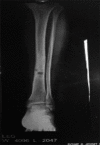Squamous Cell Carcinoma Lung with Skeletal Muscle Involvement: A 8-year Study of a Tertiary Care Hospital in Kashmir
- PMID: 29333012
- PMCID: PMC5759064
- DOI: 10.4103/ijmpo.ijmpo_169_16
Squamous Cell Carcinoma Lung with Skeletal Muscle Involvement: A 8-year Study of a Tertiary Care Hospital in Kashmir
Abstract
Aims: Lung cancer is the most common malignancy throughout the world. Nonsmall cell lung cancer (NSCLC) is the most common type, and squamous cell type is most common in India. Mostly, patients present with chest-related symptoms and signs. Isolated skeletal muscle metastasis (ISMM) is rarely seen. The aim was to see muscle metastasis and its prognosis.
Materials and methods: We are presenting our data of 8 years about this common malignancy with relation to muscle metastasis, either alone or with other system metastasis.
Results: Muscle metastasis is seen 1.5% of patients, with male: female of 8:1. Overall median survival was 15 months and progression-free survival was 12 months.
Conclusion: One peculiarity seen was ISMM with no pulmonary system and severe paraneoplastic hypercalcemia. Local therapy may be having an impact on overall survival in metachronous muscle involvement.
Keywords: Cytokeratin; isolated skeletal muscle metastasis; nonsmall cell lung carcinoma; overall survival; parathyroid hormone-related peptide; progression-free survival; superior vena cava; thyroid transcription factor.
Conflict of interest statement
There are no conflicts of interest.
Figures





Similar articles
-
Isolated Skeletal Muscle Metastasis and Hypercalcemia in Non-Small Cell Lung Carcinoma.Saudi J Med Med Sci. 2017 Jan-Apr;5(1):62-64. doi: 10.4103/1658-631X.194245. Epub 2016 Nov 16. Saudi J Med Med Sci. 2017. PMID: 30787754 Free PMC article.
-
Risk factors for skeletal-related events (SREs) and factors affecting SRE-free survival for nonsmall cell lung cancer patients with bone metastases.Tumour Biol. 2016 Jan;37(1):1131-40. doi: 10.1007/s13277-015-3907-z. Epub 2015 Aug 15. Tumour Biol. 2016. PMID: 26276360
-
Skeletal muscle metastasis from non-small cell lung cancer.J Thorac Oncol. 2009 Oct;4(10):1236-41. doi: 10.1097/JTO.0b013e3181b24509. J Thorac Oncol. 2009. PMID: 19641472
-
Metachronous solitary metastasis to the thyroid gland from squamous cell carcinoma of the lung: a case report and literature review.Tumori. 2017 Nov 15;103(Suppl. 1):e12-e15. doi: 10.5301/tj.5000605. Tumori. 2017. PMID: 28127743 Review.
-
[Parathyroid carcinoma. Therapeutic strategies derived from 20 years of experience].Minerva Endocrinol. 2001 Mar;26(1):23-9. Minerva Endocrinol. 2001. PMID: 11323564 Review. Italian.
Cited by
-
Muscle involvement by widely metastatic squamous cell carcinoma of the lung.Radiol Case Rep. 2021 May 19;16(7):1836-1839. doi: 10.1016/j.radcr.2021.04.037. eCollection 2021 Jul. Radiol Case Rep. 2021. PMID: 34040687 Free PMC article.
-
The road less travelled: Skeletal muscle invasion in oral squamous cell carcinoma.J Oral Biol Craniofac Res. 2022 Sep-Oct;12(5):516-521. doi: 10.1016/j.jobcr.2022.06.009. Epub 2022 Jun 23. J Oral Biol Craniofac Res. 2022. PMID: 35801088 Free PMC article.
References
-
- Tuoheti Y, Okada K, Osanai T, Nishida J, Ehara S, Hashimoto M, et al. Skeletal muscle metastases of carcinoma: A clinicopathological study of 12 cases. Jpn J Clin Oncol. 2004;34:210–4. - PubMed
-
- Pop D, Nadeemy AS, Venissac N, Guiraudet P, Otto J, Poudenx M, et al. Skeletal muscle metastasis from non-small cell lung cancer. J Thorac Oncol. 2009;4:1236–41. - PubMed
-
- Di Giorgio A, Sammartino P, Cardini CL, Al Mansour M, Accarpio F, Sibio S, et al. Lung cancer and skeletal muscle metastases. Ann Thorac Surg. 2004;78:709–11. - PubMed
-
- Kaira K, Ishizuka T, Yanagitani N, Sunaga N, Tsuchiya T, Hisada T, et al. Forearm muscle metastasis as an initial clinical manifestation of lung cancer. South Med J. 2009;102:79–81. - PubMed
-
- McKeown PP, Conant P, Auerbach LE. Squamous cell carcinoma of the lung: An unusual metastasis to pectoralis muscle. Ann Thorac Surg. 1996;61:1525–6. - PubMed
LinkOut - more resources
Full Text Sources
Other Literature Sources

